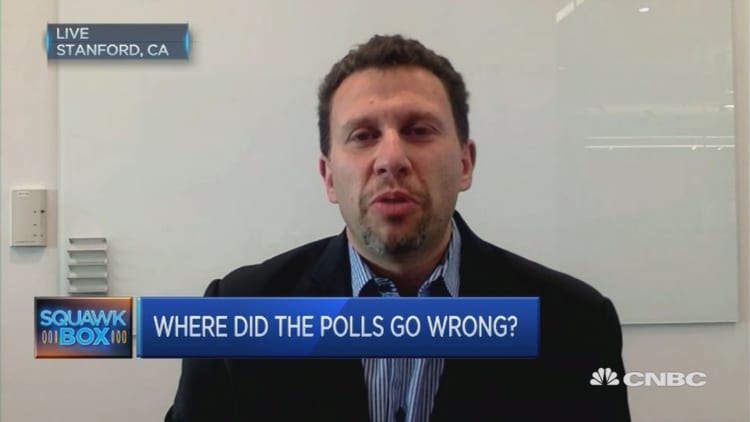Pollsters need to adjust their polling methods to take into account the growing importance of the internet as a platform, a SurveyMonkey researcher told CNBC.
Jon Cohen, senior vice president for survey research at SurveyMonkey, told CNBC's "Squawk Box" the polling industry had for decades relied on telephone responses from voters to do election polling and that the method had deteriorated dramatically over time.
"The entire industry does need to retool itself around the internet," Cohen said.
His comments followed Donald Trump's unexpected win in last week's presidential election after most polls had anticipated Democrat Hillary Clinton to emerge victorious.
On the eve of Election Day, a final poll from NBC News | Survey Monkey had shown Clinton maintaining a 6-point lead over Trump.The latter's victory came on the back of winning majority of the electoral votes, fueled by apparent wins in swing states of , , and , whereas Clinton won the overall popular vote.
"We don't know whether polls were actually wrong on voter preferences between Donald Trump and Hillary Clinton," Cohen said, arguing voter turnout on Election Day was the key factor.
"Polls can still really be good on preference but closing that gap, in terms of intention ... (and) the voting action, in this case, is something that's tremendously difficult."

There were other ways of discovering voters' intended actions that could be seen as competition for the polling industry. For example, artificial intelligence.
Last week, the founder of the Genic.AI system that correctly predicted Trump's win at the ballot box told CNBC there was a big difference between polling, which was subject to human biases, and scanning millions of data points on the internet to gauge sentiment. The AI system looked at 20 million data points from engagement in platforms such as Google, Facebook, Twitter and YouTube in the U.S. before making its projection.
This was not the first time pollsters had gotten predictions wrong. Earlier this year, numerous polling data had wrongly predicted the . would vote to remain in the .
Cohen said there were two ways the polling industry needed to evolve and harness the internet for more accurate survey results. First, by selecting a better, more random starting sample in online polls and not limiting to only the people who signed up in advance to take surveys.
Secondly, pollsters need to make new, advanced adjustments to their data points. For example, he said, it was standard practice for pollsters to do demographic adjustments to a sample to make it projectable to a broader audience.
They needed to do the same for newer data points such as the devices people were taking surveys on, for instance were the right number of people taking surveys on iPhones versus Android, among other things? Cohen said.
"We're just at the beginning of that but we're not alone in what we need to do in terms of advancing the profession."


